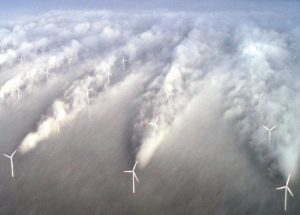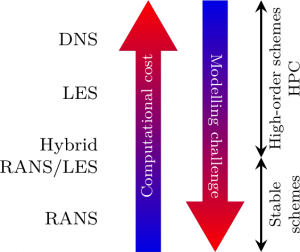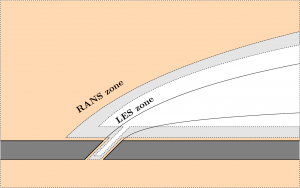Context
CFD (Computational Fluid Dynamics) plays a major role for the design of systems for aeronautics/automotive propulsion and energy production.
Most of the flows in the industry and the environment are turbulent, such that they involve a wide range of scales, from scales imposed by the geometry down to microscopic scales, as can be visualized in the Figure of a offshore windmild field beside.
The proper representation of the influence of turbulence in the simulations is based on a trade-off between the CPU cost and the accuracy. What is particularly crucial is the combined choice of the physical model and the numerical scheme. Indeed, as illustrated on the side figure, a panel of physical models, ranging from DNS (resolution of the Navier-Stokes equations) to RANS (resolution of the statistical moments) is available, with very different computational costs and modeling difficulties. But it is important to note that the requirements in terms of numerical schemes are also very different, ranging from very low dissipative high-order schemes for DNS to very stable low-order schemes for RANS.
To overcome the intrinsic limitations of the RANS method, given the unaffordable cost of DNS and LES for industrial wall-bounded flows, the only approach that can be envisioned in the next decades is the hybrid RANS/LES approach. This approach is based on the idea of using a RANS model wherever possible, and in particular in the near-wall regions, and LES only where necessary, by changing the model either abruptly or continuously. The latter case is illustrated by the figure on the right, in the example of a jet in cross-flow, representative of the cooling by multi-perforated plates in aeronautical engines. RANS is used in the boundary layer and LES only in the region of jet/boundary layer interaction. The movie below shows the results obtained with such a method, developed by the CAGIRE project-team, HTLES (Hybrid Temporal LES).
HTLES computation of a jet in cross-flow using Code_Saturne (F. Mastrippolito, R. Manceau, P. Bruel)






